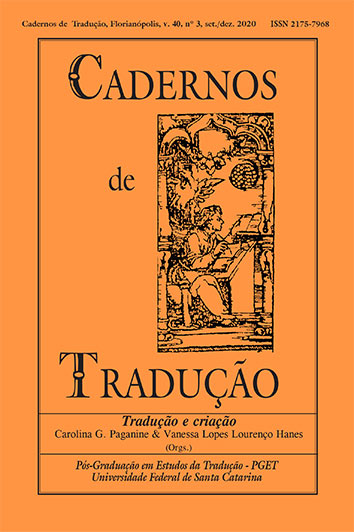A tradução enquanto processo
DOI:
https://doi.org/10.5007/2175-7968.2020v40n3p14Resumo
Concebidos tradicionalmente em torno de dicotomias bem estabelecidas, os estudos sobre tradução acabam por deixar ainda amplo espaço à construção de um caminho teórico que trate a tradução enquanto processo, não apenas como elemento implícito à existência do produto, mas com uma proposta de conceitos dotados de valor operacional. Ao trazermos a Semiótica discursiva, mais especificamente os recentes desdobramentos da abordagem tensiva de Claude Zilberberg, para dialogar com as questões basilares dos Estudos de Tradução e de Adaptação, temos como ambição apresentar uma reflexão que se liberte da lógica binária das oposições para embarcar nas tensões inerentes aos regimes de dominância de uma lógica participativa. Nossa proposta culmina na afirmação de que o que se traduz é o projeto enunciativo, um “espírito” da obra de partida que molda suas características mais marcantes, do qual emana o
que denominamos arco tensivo, um perfil sensível da obra, passível de ser modulado a partir do conjunto de estratégias de textualização de que o enunciador se vale, com suas cifras tensivas subjacentes. Procuramos mostrar que um caminho possível em direção ao interstício da oposição binária pode ser trilhado e aprofundado em várias frentes.
Referências
Arrojo, Rosemery. Oficina de tradução - A teoria na prática. São Paulo: Atica, 1986.
Britto, Paulo Henriques. Tradução e criação. Cadernos de Tradução, v.1, n.4, p.239-262, 1999. Disponível em: https://periodicos.ufsc.br/index.php/traducao/article/view/5534/4992. Acesso em: 15/12/2019
Campos, Haroldo de (a). Metalinguagens e outras metas. São Paulo: Perspectiva, 2006.
Campos, Haroldo de (b). Transcriação. Marcelo Tápia e Thelma Médici Nóbrega (orgs.). São Paulo: Perspectiva, 2015.
Eco, Umberto (a). Dire quasi la stessa cosa. Milão: Bompiani, 2010.
Eco, Umberto (b). Os limites da interpretação. Tradução de Pérola de Carvalho. São Paulo: Perspectiva, 2012.
Greimas, Algirdas Julien; Courtés, Joseph. Dicionário de Semiótica. Tradução de Alceu Dias Lima et al. São Paulo: Contexto, 2008.
Paz, Octavio. Tradução: literatura e literalidade. Ed. Bilíngue. Tradução de Doralice Alves de Queiroz. Belo Horizonte: FALE/UFMG, 2009.
Ricouer, P. Sobre tradução. Tradução de Patrícia Lavelle. Belo Horizonte:Editora UFMG, 2011.
Sontag, Susan. Against interpretation and other essays. New York: Picador, 2013.
Tatit, Luiz. Passos da Semiótica Tensiva. São Paulo: Ateliê Editorial, 2019.
Valery, Paul. Variations sur les Bucoliques. Traduction en vers des Bucoliques de Virgile. Paris: NRF, 1955.
Venuti, Lawrence. The translator’s invisibility: A history of translation. Routledge: London, 1995.
Zilberberg, Claude (a). “Défense et illustration de l’intensité”. In: Fontanille, Jacques (org.). La quantité et ses modulations qualitatives. Limoges, Amsterdam e Philadelphia: PULIM e Benjamins, 1992.
Zilberberg, Claude (b). Elementos de Semiótica Tensiva. Tradução de Ivã Carlos Lopes, Luiz Tatit, Waldir Beividas. São Paulo: Ateliê Editorial, 2011.
Downloads
Publicado
Como Citar
Edição
Seção
Licença
Autores têm autorização para assumir contratos adicionais separadamente, para distribuição não exclusiva da versão do trabalho publicada nesta revista (ex.: publicar em repositório institucional ou como capítulo de livro, com reconhecimento de autoria e publicação inicial nesta revista).





















































